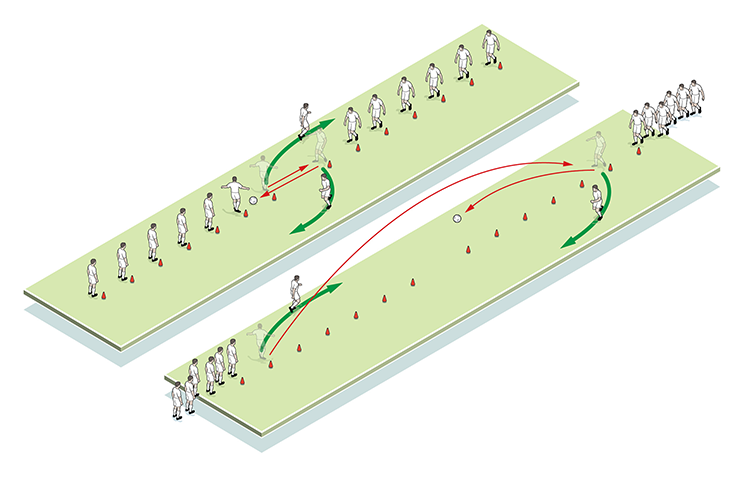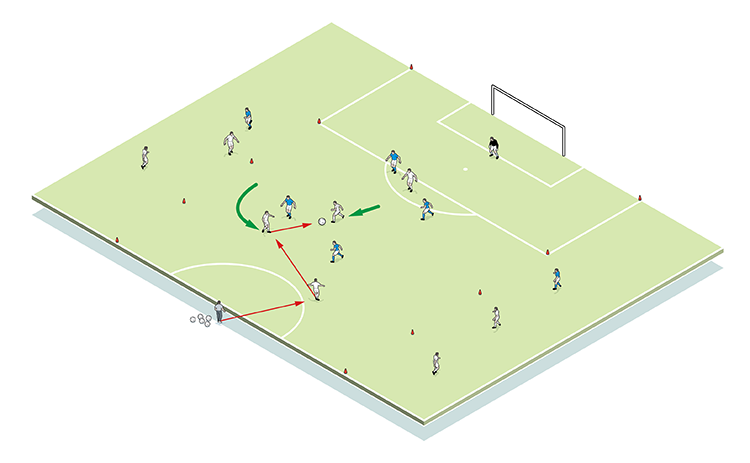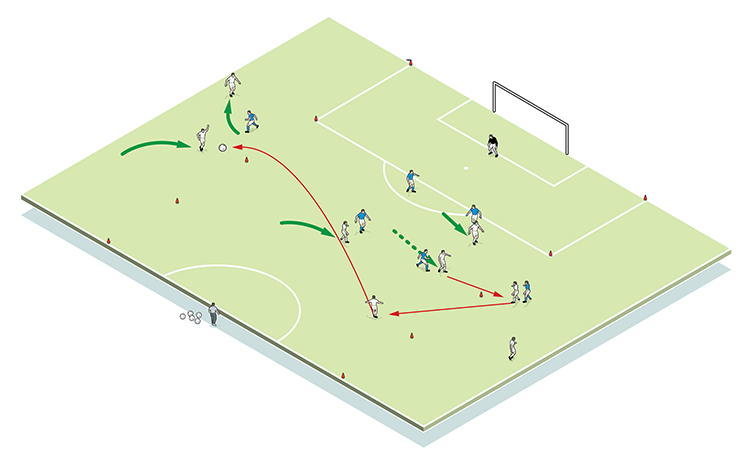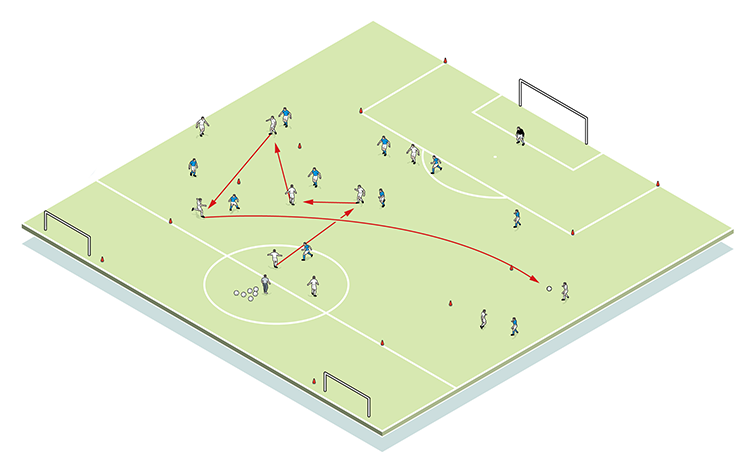You are viewing 1 of your 1 free articles
Changing the point of attack
Being able to quickly, efficiently and, at times, discretely change the point of attack is crucial for any team. The goal of this session is therefore to demonstrate the different ways the ball can be transitioned from one side of the field to the other, as well as highlighting what types of passes and movements are needed.
| Area | Up to a half-pitch extended by 10 yards |
| Equipment | Balls, cones, goals |
| No. of Players | Up to 20 |
| Session Time |
Stage 1 20mins, Stages 2 and 3 15mins (3x3mins with 2min rests), Stage 4 2x10min halves |
Being able to quickly, efficiently and, at times, discretely change the point of attack is crucial for any team. The goal of this session is therefore to demonstrate the different ways the ball can be transitioned from one side of the field to the other, as well as highlighting what types of passes and movements are needed.
What we’re looking to achieve is both wide players and central players becoming proficient in the ways they can take responsibility for the transition so that an alternate attacking opportunity can be produced and, we hope, a goal scored.
Remember, when your team is in possession the opposition’s prime objective is to have proper cover and balance in their team. A quick change of attack to utilise space on the opposite side of the field, using 1v1s and 2v1s, can easily unsettle the other team.
What do I get the players to do?
Stage 1 - warm-up
We begin with a simple passing exercise, as shown (1), in order to get the players used to transitioning the ball from side to side, expanded to involve long driven balls.
1

Stage 2 - small-sided activity
This is 8v6 plus a keeper, with the overloading team attacking one central goal (2a). Players 2 and 7 stay in the wide right channel, with 3 and 11 in the wide left. Players 6 and 8 must move the ball quickly to wide areas to provoke attacks (2b), with number 10 also asked to transition the ball using one- or two-touch play. Players in wide channels can play with unlimited touches and all passing must
be at high speed. Should defenders win the ball, it’s returned to the server.
2a

2b

To progress, combination play is introduced to encourage interaction between central players so they think one pass ahead. Then we encourage direct and driven long balls in switching play with one pass (2c).
2c

What are the key things to look out for?
Technically, passing must be crisp and clean. For two-touch transitions, the first touch must be under control to lead to a clean pass; for one-touch play, players must be led into space away from pressure to keep the tempo high.
For longer passes, direct driven balls need to be emphasised rather than any passes with ‘air’ under them. But overall, the key component is getting the ball to the other side as quickly as possible.
Tactically, players must understand when to change the point of attack. An overload of defenders usually indicates the change is necessary - prolonged possession in a specific area can provoke this opportunity.
Stage 3 - expanded small-sided activity
We move to 10v9 plus a keeper, as shown (3), allowing the defending team to attack two counter goals positioned 10 yards in from each sideline. We add two attckers and three defenders. Giving defenders goals to attack means the attacking team must transition from defence to attack, offering additional opportunities to switch the ball.
3

Related Files
Editor's Picks
Intensive boxes drill with goals
Penetrating the final third
Creating and finishing
My philosophy
Pressing initiation
Compact team movement
Defensive organisation
Back three tactics
Counter-pressing as an offensive weapon
Coaches' Testimonials

Alan Pardew

Arsène Wenger

Brendan Rodgers

Carlos Carvalhal

José Mourinho

Jürgen Klopp

Pep Guardiola

Roy Hodgson

Sir Alex Ferguson

Steven Gerrard
Coaches' Testimonials

Gerald Kearney, Downtown Las Vegas Soccer Club

Paul Butler, Florida, USA

Rick Shields, Springboro, USA

Tony Green, Pierrefonds Titans, Quebec, Canada
Join the world's leading coaches and managers and discover for yourself one of the best kept secrets in coaching. No other training tool on the planet is written or read by the calibre of names you’ll find in Elite Soccer.
In a recent survey 92% of subscribers said Elite Soccer makes them more confident, 89% said it makes them a more effective coach and 91% said it makes them more inspired.
Get Monthly Inspiration
All the latest techniques and approaches
Since 2010 Elite Soccer has given subscribers exclusive insight into the training ground practices of the world’s best coaches. Published in partnership with the League Managers Association we have unparalleled access to the leading lights in the English leagues, as well as a host of international managers.
Elite Soccer exclusively features sessions written by the coaches themselves. There are no observed sessions and no sessions “in the style of”, just first-hand advice delivered direct to you from the coach.








